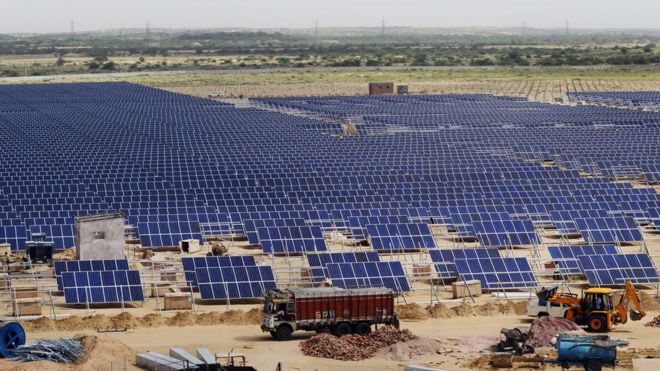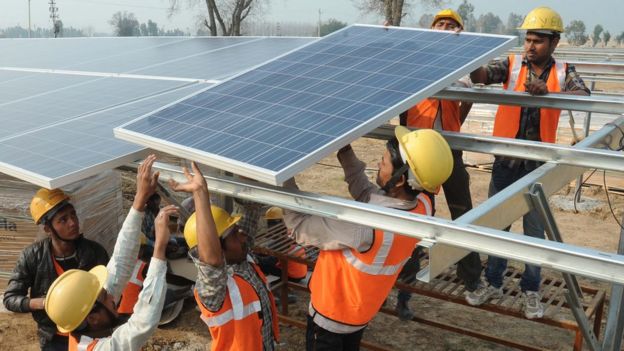 AFP
AFP
Whatever happened to all the talk of international co-operation to tackle climate change that we heard during the climate conference in Paris just a few months ago?
That is what many environmentalists are asking after the United States delivered a damaging blow to India's ambitious solar power programme this week.
In response to a US complaint, a World Trade Organization (WTO) panel has ruled that India's National Solar Mission breaches trade rules.
It judged that India's policies on buying locally made solar power equipment discriminates against imports.
"The ink is barely dry on the UN Paris Climate Agreement, but clearly trade still trumps real action on climate change," Sam Cossar-Gilbert of Friends of the Earth International said in a statement.
But is the decision really as damaging as many commentators seem to think?
Let's start at the beginning.
Solar centrepiece
One of the biggest achievements at the Paris climate change conference was drawing India into the architecture of international climate agreements.
 AP
AP
It refused to commit to a ceiling on carbon dioxide emissions but did promise big increases in the carbon efficiency of the economy - the amount of carbon emitted per unit of GDP.
A key part of that commitment was the promise of huge investment in renewable technologies, including a vast increase in solar power.
India said it would add 100 GW of solar capacity by 2022.
That's more than the current solar capacity of the world's top five solar-producing countries combined.
And - you guessed it - the National Solar Mission was the centrepiece of the whole shebang.
India's National Solar Mission
- Launched on 11 January 2010 by then PM Manmohan Singh
- Targets ramping up India's solar power capacity to 100 GW by 2022
- Aims to reduce the cost of solar power generation in the country through long-term policy, aggressive research and development (R&D), and domestic production of critical raw materials, components and products
- Aims to make India a global leader in solar energy
But while the US was carefully reeling India into the climate talks it had simultaneously lodged a complaint with the WTO, arguing that India's solar programme created unfair barriers to the import of US-made solar panels.
It is certainly true that India's plans include a "buy local" policy.
The Solar Mission is explicitly designed to make India one of the biggest players in the rapidly growing international solar industry.
Indeed, developing solar is a key thrust of Prime Minister Narendra Modi's signature "Make in India" policy.
Pros and cons
And here's where the interesting economic arguments come in.
 AFP
AFP
Because the presumption in most of the commentaries I've read on this is that buying local content is necessarily a good thing.
Take a look at this article in the online environmental magazine Grist, or this piece in the Huffington Post, which maintains: "The ruling shows that decades-old, over-reaching trade rules are out of sync with the global challenge to 100% clean energy."
Lots of economists would say that that is muddle-headed.
Think about what the "buy local" rules are really about.
They are there to shield local capitalists - Indian-based solar panel companies - from competition from abroad.
That means one of two things.
Secure behind the protective barrier, they get to pocket extra profits.
Alternatively they are able to run less efficient businesses.
Either way the people who buy the panels lose out because they end up paying more.
The case is made very well in this Forbes article, which argues that the WTO rules are there to right an inherent imbalance between producers and consumers.
Environmental benefits
The problem is that local businesses tend to feel very strongly indeed about creating that comfortable competition-free space, so they lobby government hard for it.
Their customers aren't so motivated to make a fuss so the manufacturers tend to win out.
 AFP
AFP
That's where the WTO agreements come in, tilting the trade disputes like this in favour of consumers.
That is why - runs the argument - the WTO ruling against India will actually have huge environmental benefits.
The WTO is ensuring that India's solar ambitions are achieved in the most efficient way possible because the Indian businesses that want to generate solar power get to buy the cheapest solar panels.
That is certainly what the American solar industry says.
"This decision helps us bring clean energy to the people of India, as that nation's demand for electricity rapidly grows," Dan Whitten of the Solar Energy Industries Association told PV-Tech magazine.
India, of course, disagrees.
It argues that developing an indigenous solar industry will in time boost international competition and therefore reduce the price of solar panels for everyone.
And no doubt India will be tempted to point to the hypocrisy in US trade policy.
While the US argues for unfettered free markets in international forums like the WTO, it doesn't practice what it preaches at home.
Half of all US states have subsidies for renewables.
Perhaps India should file a counter-complaint with the WTO against the US.
No comments:
Post a Comment